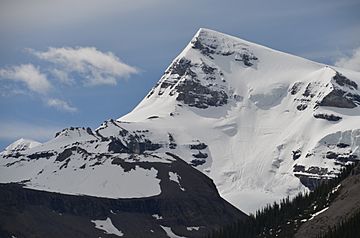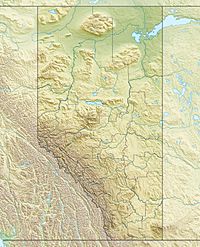Mount Charlton (Canada) facts for kids
Quick facts for kids Mount Charlton |
|
|---|---|
 |
|
| Highest point | |
| Elevation | 3,217 m (10,554 ft) |
| Prominence | 197 m (646 ft) |
| Parent peak | Mount Brazeau (3470 m) |
| Listing | Mountains of Alberta |
| Geography | |
| Location | Alberta, Canada |
| Parent range | Queen Elizabeth Ranges Canadian Rockies |
| Climbing | |
| First ascent | 1921 W.R. Hainsworth, M.M. Strumia |
Mount Charlton is a tall mountain peak in Alberta, Canada. It stands about 3,217 meters (10,554 feet) high. You can find it on the west side of Maligne Lake inside Jasper National Park. This park is part of the amazing Canadian Rockies mountain range. The mountain closest to Mount Charlton, and a bit taller, is Mount Unwin, which is only about 1.2 kilometers (0.75 miles) away to the west.
Contents
The Story Behind Mount Charlton
How It Got Its Name
Mount Charlton was named in 1911 by a famous explorer named Mary Schäffer. She named it after H. R. Charlton. He was an important person who worked for the Grand Trunk Pacific Railway. He helped with advertising for the railway.
First Climbers
The very first ascent (when people successfully climbed to the top) of Mount Charlton happened in 1921. Two climbers, W.R. Hainsworth and M.M. Strumia, were the first to reach its summit.
Official Name
The name "Mount Charlton" became official in 1947. This was decided by the Geographical Names Board of Canada. They are the group that makes sure all places in Canada have official names.
Weather and Climate
Mount Charlton is in a place with a subarctic climate. This means it has very cold winters with lots of snow. The summers are usually mild, not too hot.
Temperatures and Wind
In winter, temperatures can drop below -20 degrees Celsius (-4 degrees Fahrenheit). With the wind, it can feel even colder, sometimes below -30 degrees Celsius (-22 degrees Fahrenheit)!
Water Flow
The snow and rain that fall on Mount Charlton eventually melt and flow away. This water drains into the Maligne River. The Maligne River then flows into the larger Athabasca River.



